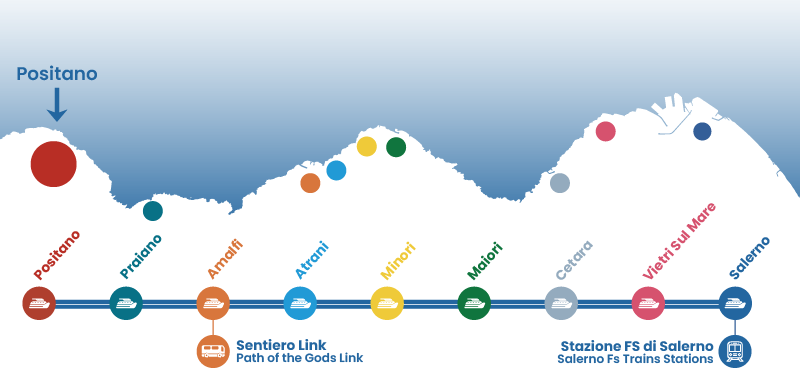Positano
The pearl of the Amalfi Coast, known as the “vertical city,” is famous worldwide for its glamorous and breathtaking beauty.
Positano, The "Pearl of the Amalfi Coast"
Positano is considered the "Pearl of the Amalfi Coast" and if you're visiting this fantastic coastline, it's a must to dedicate a day to discovering this charming and picturesque town, undoubtedly one of the most popular destinations for tourists from all over the world. The first evidence of a settlement in Positano dates back to prehistoric times while the first archaeological proof dates back to the first century B.C., when the Romans made it a place of holiday and a summer otium, thanks to its mild temperatures and the beauty of the landscape. Numerous and significant traces from this period can be found in the Roman Archaeological Museum of Positano, an archaeological site turned museum that was inaugurated in 2018.
However, the real touristic boom of the town occurred after the Second World War, when the city, recognizable by its vertical structure of colorful houses stacked against each other and carved into the rocky cliff, became a vacation destination for the international jet set.

Here, royal princes, industrialists, actors, writers and politicians began spending their summers, making Positano world-famous. In the 1960s and 1970s,it was a regular retreat for Jacqueline Kennedy and her children, industrialist Gianni Agnelli, John Steinbeck, Franco Zeffirelli, Liz Taylor and Rudolph Nureyev along with many other famous figures. Photos of these celebrities on the Amalfi Coast circulated globally, turning this magical and evocative place into a coveted destination for international tourism. It was during this time that artisanal activities began to flourish, and they remain Positano's pride today: ceramic workshops, custom-made leather sandals, and lightweight linen and cotton clothing from "Moda Mare Positano," a summer fashion trend that quickly became a true lifestyle for vacationing VIPs and celebrities.
What to see and what to do in Positano?
\1
Church of Santa Maria dell'Assunta
The Church of Santa Maria dell’Assunta, dating back to the 10th century with its yellow and green majolica dome, is located in the lower part of the town, close to the sea and is captured each year in the photos of millions of tourists. Inside, it houses a Byzantine icon of the Black Madonna with Child, to which an ancient legend attributes the origin of Positano's name. Legend has it that in the 12th century, the painting of the Virgin Mary was aboard a ship with Benedictine monks. Encouraged by a voice from the painting itself saying "Posa ... Posa", meaning "Stop here", they decided to stop on the shores of Positano.
\2
MAR, Roman Archaeological Museum
It is an archaeological site turned into a museum, divided into two crypts and a room from a Roman maritime villa that was buried by the eruption of Mount Vesuvius in 79 AD, the same catastrophe that struck the more famous Pompeii and Herculaneum. Discovered in the 1920s by a butcher who was digging a corridor to create a cold storage room for his meats, the Roman villa was only opened to the public in 2018, after years of restoration work.
Its magnificently preserved frescoed walls are the only example of wall painting from Roman villas on the Amalfi Coast, while countless artifacts, unearthed during the excavations, attest to the wealth of its owner, presumably Posides Claudi Caesaris, a freedman of Emperor Claudius, from whom the name of Positano is thought to originate.
\3
The Saracen Towers
The Sponda, Trasita and Fornillo Saracen towers are watchtowers built in the 16th century as a defense against pirates. Their outposts were tasked with warning the population in the event of an attack from the sea, giving them time to seek refuge in the hills.
\4
The beaches of Positano
Spiaggia Grande, Fornillo, Arienzo, La Porta and Laurito, with their deep cobalt-blue waters, are awarded Italy's Bandiera Blu (Blue Flag) recognition each year, a label that honors the most pristine marine waters.
\5
The Path of the Gods
It is a medium difficulty trekking route of about 8 km that connects Nocelle, a hamlet of Positano on the slopes of Mount Pertuso, to Agerola, a village on the hills of the Amalfi Coast. Its name derives from the legend that it was the road that the Greek gods traveled to save Ulysses from the sirens that were on the island of Li Galli.
The path that winds through the Mediterranean scrub, vines and prickly pear plants is famous for the spectacular panoramas on the Amalfi Coast and Capri. It is advisable to face it with an expert guide because of the exposed sections and no handrails.
\6
Shopping e Food
Shopping in the numerous art galleries displaying works by contemporary artists, and in the various local craft shops where you can buy brightly colored ceramics in shades of the sun and sea, custom-made leather sandals often decorated with crystals, shells, and colorful stones, and finally, light linen and cotton garments designed and crafted by local seamstresses, exclusive pieces from the famous “Moda Mare Positano.”
Enjoying fresh seafood in one of the seaside restaurants and indulging in delicious desserts and citrus-flavored ice creams from the coast.




